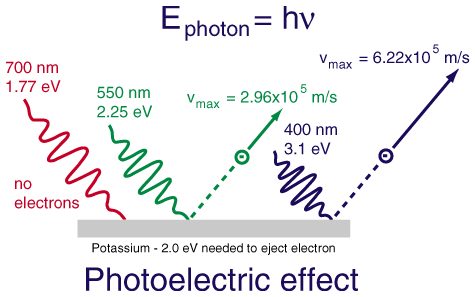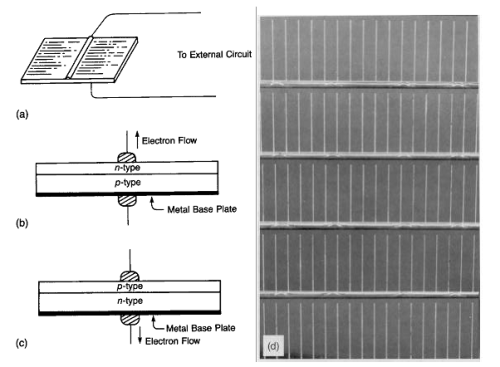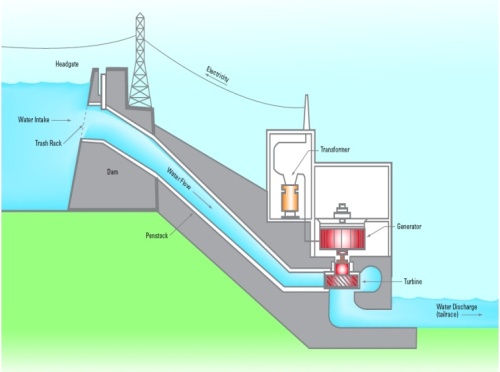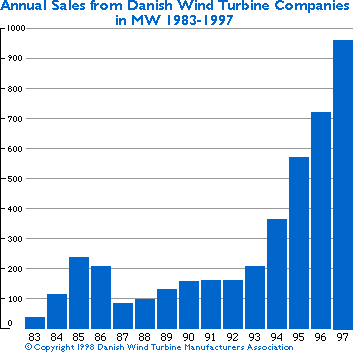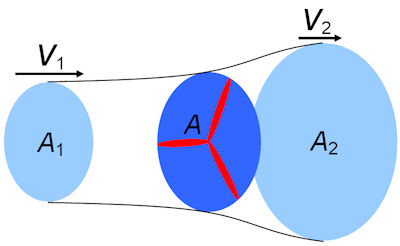Wind Energy as an Alternative
Shuainan F., Jing S., Shawn T.
Brief Description of Wind Power
Wind is generated when the sun heats up land, the air around the land will absorb the air and there will be a creation of warmer air. At a particular temperature, the hot air will rise quickly because it is lighter than cool air. Fast air particles will exercise more pressure than the slow moving particles. This means that it will take smaller amounts of hot air particles to maintain the given air pressure at a particular elevation. When the hot air rises due to its lighter mass, the cool air will rush in to fill the gap that the hot air has left. The rush of the cool air is what is known as wind. Using the wind, it is possible to generate electricity that can be used in everyday life as an alternative energy source.
Topic ideas
Main Topic idea: Physics of Wind Power
Sub-topic idea 1: Classical Physics Concepts of Energy, Momentum, and Power
Sub-topic idea 2: Structure of the Turbine and its Significance
Sub-topic idea 3: The Importance of the Generator
Sub-topic idea 4: Inside a Generator
Sub-topic idea 5: Magnetic Force and Electromagnetic Force
Societal Implications
This type of alternative energy is very reliable for energy consumption in the long term, as wind is a resource that will is infinite and renewable. This type of energy generation is much more sustainable than fossil fuels as it does not pollute the environment or produce radioactive or toxic waste. Despite the cost of installation of a wind turbines, wind energy is much more economic than fossil fuels. Wind power may cost a slight bit more than fossil fuel generated power, but it much better for the environment. In more windy areas, there is sometimes so much power generated, that it is possible to sell energy back to the power company!
Wind energy is not only reliable, but it is pollution free, and is cost efficient. It can take as little as one efficient wind turbine to generate enough energy to power an entire household.
Topic 1 Classical Physics Concepts of Energy, Momentum, and Power
Wind Energy is a form of energy that involves using a wind turbine as an electric generator to convert the kinetic energy of the wind to electric energy. Wind turbines consists of a rotor comprised of three blades. These components are placed on a pole with an average height of 20 meters from the ground. Generally, the higher the rotor is placed, the stronger the wind gusts are. In order to optimize the output of the wind, three factors need to be considered. Stronger wind means a wind with higher speed and force; this means that more power will be generated.
From the formula Ek = ½ mv2 , it can be seen that speed and kinetic energy are directly proportional. When there is more speed, there will be a greater kinetic energy. Using the formula: P = E/t, when there is more energy, power (energy/second) will also increase. This is because energy is directly proportional to power. Therefore a higher velocity will result in more power being generated.
Another factor that will increase the output of energy is the size of the turbine rotor and blades. A larger rotor and blades means more mass. Using the momentum formula: p = mv, mass is directly proportional to momentum. This means that the greater the mass of the motor, the greater the momentum of the motor, Ft = p.
Since momentum and time are directly proportional, an increase in momentum would result in an increase in time. Thus, a turbine of more mass would spin for longer even without wind continually driving it. P = E/t , hence Pt = E.
From this formula, time and energy are directly proportional, the longer the turbine is spinning, the higher its energy output.
Topic 2 Structure of the Turbine and its Significance
The structure of a wind turbine plays a crucial role in the functionality and workings of wind power. Not only does the wind need to be able to turn the blades, but the whole process must be made efficient, so as to generate maximum amount of energy possible. This way, not only is wind power a clean alternative to coal and other hydrocarbon combustion processes, but it is also at least comparable to, or beats the 40% efficiency of a thermo-electric power plant that runs off of hydrocarbons.
The structure of a wind turbine can be summarized in the following diagram:

Figure 1: Parts and components of a wind turbine
The process of generating power with a wind turbine is identical to the process used by hydrocarbon combustion. They both use a generator, and an external source of energy to turn the generator. The only difference is the type of energy input used. With hydrocarbons, the energy input starts off as the chemical energy stored in bonds between atoms in fossil fuels such as coal and natural gas. When these substances are combusted (reacted with oxygen), the chemical energy gets converted to thermal energy. This energy then is transferred to water molecules, boiling off the water as steam, which in turn drive a steam turbine attached to a generator. At this point, the chemical energy of the hydrocarbon fuel source is now the kinetic energy of the steam turbine, which in turn gets converted to electrical energy via the generator. Wind power however, undergoes less energy conversions, and is therefore a much more simple set of steps.
Simply put, a wind turbine is a generator attached to a set of blades, and a rotor. The blades are angled in such a way that when wind blows on them, the kinetic energy of the fast-moving air molecules is transferred to the blades and rotor of the turbine, causing the turbine to spin. Because the rotor of the turbine is linked to the generator via a system of shafts and gears (as seen in the diagram above), the generator gets spun, converting the kinetic energy of the wind turbine into electrical energy.
Topic 3 The Importance of the Generator
The generator (structure 7) is the heart of the wind turbine. Without this amazing piece of machinery, the turbine is not much more than a tall, metallic pinwheel. While it is obvious what the generator’s role is, what is it exactly that allows this piece of equipment to operate? The answer requires looking into the inner workings of the generator, and concepts of electromagnetism that contribute to the technology that drives this powerful machine.
Topic 4 Inside a Generator
A generator has the exact same structure as a motor. The only difference between the two is the input and output energies. Whereas in a motor the input energy is electricity and the output is kinetic energy, a generator requires an input of kinetic energy and supplies an output of electricity. There are two types of generators as there are motors (alternating current, or AC, and direct current, or DC). Typically, when it comes to an application that is as large as electricity generation for a large area (such as big-scale wind farms in the countryside do), the generator type is AC. A personal-sized wind turbine however, such as the ones used by people in their backyard, usually contains a DC generator.

Figure 2: The inside parts of an AC generator.
The generator is composed of a set of magnets to provide the magnetic field and magnetic force required to move electrons (i.e. create a current flow), a set of spinning coils in the magnetic field, where the current is initiated, slip rings, which are linked to wires carrying current out of the generator, and brushes, which allow the slip rings to contact the wires while not disturbing the spinning of the wire coil. A spindle is then attached to the generator along the axis of rotation, to allow the generator to be spun. A DC generator is very similar, with only a minor difference in terms of structure – instead of slip rings, it contains a split-ring commutator:

Figure 3: The insides of a DC generator.
Combining only these relatively simple few structures together (but there may be many of one structure), and an external force to turn the spindle of the generator, large, high-output wind turbines are made capable of cranking out power at rates of up to 50 kilowatts (50 000 watts)! How is it that these few simple structures allow such a big achievement?
Topic 5 Magnetic Force and Electromagnetic Force
Magnetic force and electromagnetic force are the two principles that allow the generator to perform its task. Imagine the classical experiment from science class of thrusting a bar magnet into a coil of wire that is hooked up to a galvanometer. What do you observe? The needle of the galvanometer suddenly jumps, indicating that there is current flowing through the wire. Hence, this is named the generator effect, and the current is an induced current known as electromagnetic force. The generator of a wind turbine (either AC or DC) operates using the same principle.
Looking back to figure 2 of the AC generator, the open left-hand rule can be applied to the generator. To do this, select one half of the coil that is moving in a specific direction. Then, point the fingers of the left hand in the direction of the magnetic field (from the north pole to the south pole), and the thumb in the direction the wire coil is moving. The outward direction the palm is now facing is the direction of the magnetic force, the force that pushes electrons in the atoms of the wire. Because the wire is made of metal, and metallic atom nuclei have very weak holds on their electrons, the magnetic force can easily push electrons in a certain direction in the wire. Since the halves of the ring are moving in opposing directions, the current induced in the parallel sections are in opposing directions. Because it is connected at the top, the overall current is in the same direction, and an electric current them flows in the wires attached to the slip ring brushes. But where does the alternating current kick in?
Since the generator is obviously not going to keep switching its direction of spin, and neither is the magnetic field, the magnetic force must change in order to create the alternating current. Look closely at the diagram, and use the open-left hand rule. As soon as the generator makes a half-way spin and now the loop halves have switched spots, the magnetic force in each half is in the opposing direction as what it was when the loop was on the other side. This causes electrons to continuously switch their direction as they get pushed around by the magnetic force generated. Hence, alternating current has no fixed direction, and electrons continually flow back and forth in a wire.
So, what prevents the same thing from happening in a DC generator then? During the switch where the two wire coils end up on opposite sides, the split-ring commutator prevents the brushes from contacting anything at all. And when the switch is complete, each brush is contacting the piece of the commutator that the previous brush was contacting. This ensures that the part of the wire coil that is on the right side (magnetic force in a certain direction) at the moment will always contact the wire that is attached to the right side, and the part of the coil on the left side (magnetic field in another direction) always contacts the wire attached to the left. Therefore, no such reversal in current occurs, and a direct current is generated.
Topic 6 Why Alternating Current?
A common question is, why is alternating current used for large-scale electricity generation, if most appliances use direct current? The answer is related to the efficiency of transporting a current over a long distance. Since it is obvious that the energy is going to be lost due to resistance of the wire it is transported over, it is desirable to minimize this loss as much as possible. To maximize efficiency, the voltage of the electricity must be stepped up. A property of alternating current that direct current lacks is its ability to be stepped up or down in terms of voltage. This is not only useful to make transporting over long distance efficient, but also allows the voltage to be adjusted accordingly before it is used.
Conclusion
Clearly, wind energy is advantageous in terms of eco-friendliness and in terms of costs, due to its relative simplicity and its rather high output. Of course, there are drawbacks with wind energy, as there are with anything, but there are many more advantages than there are drawbacks. So why not choose it over other forms? Converting to wind energy is a breeze!
References and Citations
- Alternative Energy. (2009, July 24).What factors affect the output of wind
turbines? Retrieved December 29, 2012, from http://www.alternative-energy-news.info/what-factors-affect-the-output-of-wind-turbines/
- howstuffworks. (n.d.). How Wind Power Works. Retrieved December 29, 2012,
from http://science.howstuffworks.com/environmental/green-science/wind-power.htm
- The Electricity Forum. (2012). Wind generated electricity. Retrieved December
29, 2012, from http://www.electricityforum.com/wind-generated-electricity.html
- The Marsmen Website. (2005). How do Wind Turbines Work? Retrieved
December 29, 2012, from http://marsmen.webs.com/windpoweronmars.htm
- Tutor Notes. (2011). AC Generator – Electromagnetism. Retrieved January 2,
2013, from http://www.tutornotes.com.hk/ac_generator/

